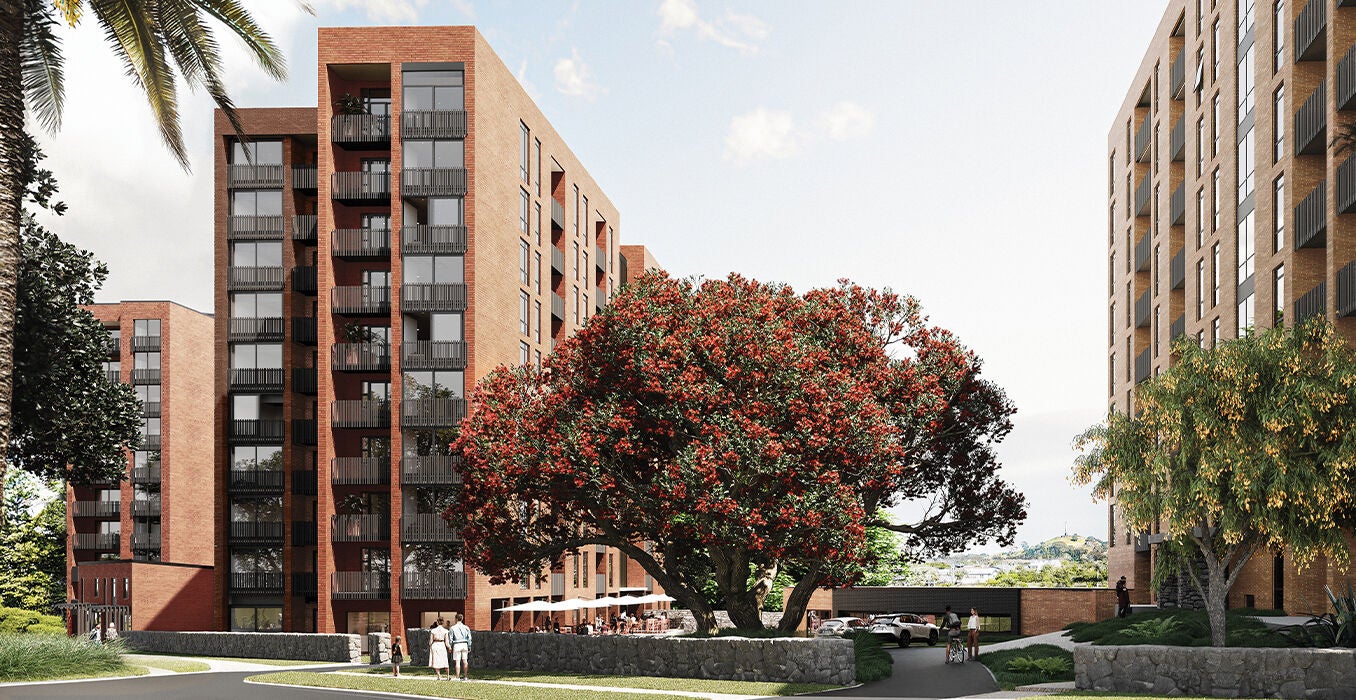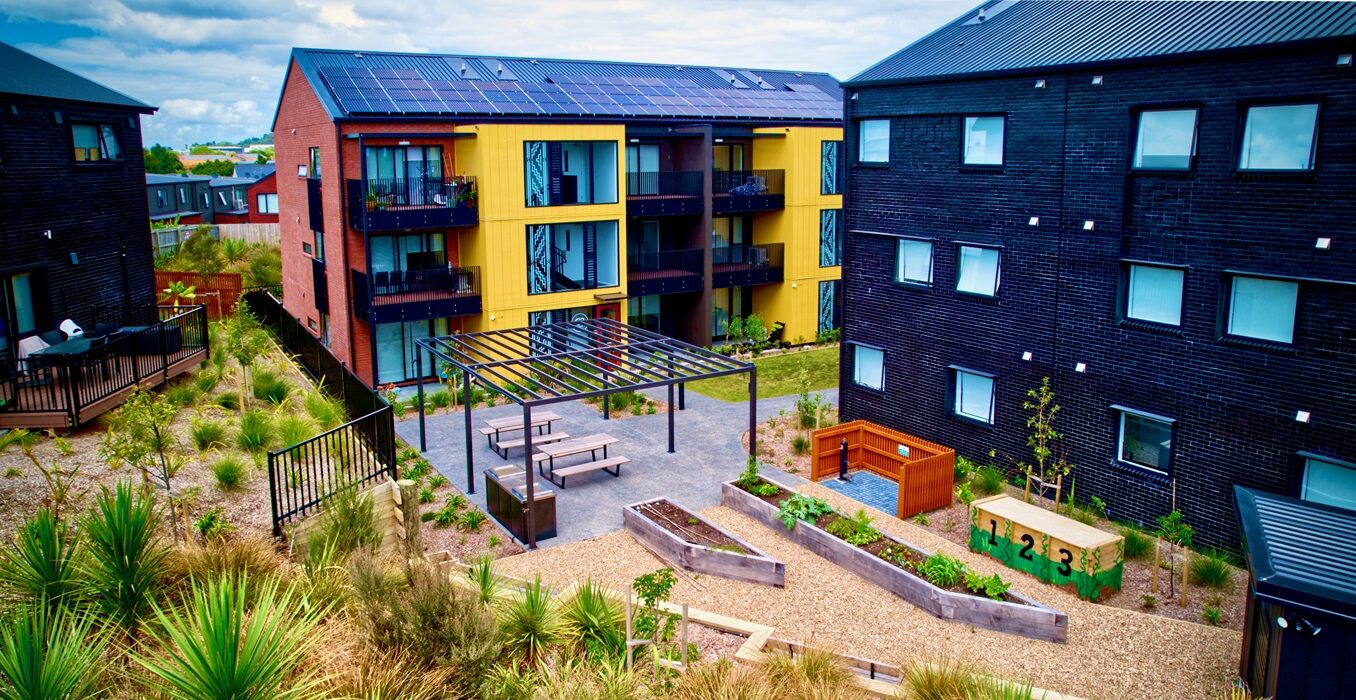Total Property -
Rented future

Artist's impression of Simplicity Living's planned BTR community adjacent to Auckland's Ellerslie Racecourse
Building on discussions held during the recent New Zealand Green Building Council Housing Summit 2024, the country’s build-to-rent changemakers discuss the sector’s dual promise for housing supply and sustainability.
Changing lifestyles and a lack of affordable housing have spurred a surge of interest in the global build-to-rent (BTR) sector, offering institutional investors, developers, professional management companies, and occupants an opportunity to reshape New Zealand’s housing market for a brighter future.
In renter-centric regions like the United Kingdom and Germany, BTR is thriving, with a proven track record of providing investors with stable and long-term returns. Meanwhile, residents benefit from secure tenancies in high-quality, newly developed, professionally managed communities near employment and transit hubs.
Experts suggest that while New Zealand may have been slow to join the global movement, we are catching up, with an acceleration driven by a shift towards more investment-friendly legislation, innovative building techniques, and a growing emphasis on environmental, social and governance (ESG) credentials.
SUPPLY SOLUTIONS
With homeownership unaffordable for many, renting is on the rise, meaning we can increasingly see the value of BTR as a strategy to help ease our housing concerns, says Bayleys director of strategic advisory Paula Bennett.
As the chair of recent Housing Summit 2024 discussions on the subject, Bennett says the sector is poised for growth, particularly given recent legislative support and a shift in the social psyche about traditional homeownership.
“We can see from global success that there is a significant opportunity in New Zealand for BTR to help address the housing shortfall and provide quality accommodation, particularly as net migration remains high and the construction pipeline is challenged.
“Given New Zealand’s comparatively small scale and a reliance on global capital, the conversation has traditionally centred on attracting institutional investment players to kickstart these projects. Excitingly, several local providers have moved into the development phase of their projects, shifting the focus from ‘How do we attract investment’ to ‘How do we increase building efficiency?’”
EMBEDDING ESG
New Zealand Green Building Council (NZGBC) chief executive Andrew Eagles says it is encouraging to see New Zealand’s BTR players elevating their products with ESG efficiencies, positively impacting both sustainability and financial performance.
“In delivering lower energy homes that are climate resilient and supportive of the way Kiwis want to live, work and play, BTR developers are leading an important movement that confirms to investors the necessity of ESG principles, particularly as the sector prepares for potential future change in Building Code standards.
“Providers like New Ground Capital, Simplicity Living, and Kiwi Property are demonstrating their commitment by utilising the NZGBC’s independent national rating tool – Homestar – to reflect the health, warmth, efficiency and adherence to high sustainability standards on their BTR projects.”
Looking beyond the ‘safe’ carbon-friendly designs that have worked in the past, Eagles says there is an emerging challenge in embodied carbon.
“Developers are increasingly looking at the big picture here – consideration of the total emissions associated with all stages throughout a product’s lifecycle. This includes the energy consumed in manufacturing processes, transport, performance, ongoing efficiencies, and post-occupancy reporting.
“By looking at the asset’s operational life, there are flow-on effects for the entire supply chain, right down to the ability to insulate residents from cost-of-living pressure points like rising electricity costs.”
POST-OCCUPANCY INTEGRITY
Whole-of-life considerations are paramount in leading BTR developer New Ground Capital’s latest project in the east Auckland suburb of Glen Innes.
Managed in partnership with iwi-owned housing collective Hāpai Housing, the 50 residences in its Moroki community have been offered to tenants with long-term leases of up to 10 years, with each dwelling gaining Homestar certification from the NZGBC and generating healthy energy savings that reduce operational costs for tenants.
“Moroki’s new homes need 40-percent less power and water than homes of similar sizes built to New Zealand Building Code standard. How this project has been designed, built, and operated will lead to considerable savings for tenants’ monthly bills,” says New Ground Capital co-founder and managing director Roy Thompson.
In managing the data to support these cost efficiencies, the approach highlights the effectiveness of maintaining consistent management from development into occupancy while also facilitating continuous improvement. Furthermore, it demonstrates that the evaluation processes embedded in the Homestar rating tools are vital for closing the performance gap between design and operational energy use.
“Implementing technology that provides insight complements our energy efficiency objectives, enabling us to go beyond standard building regulation requirements and identify improvements from one project to the next. These innovations are increasing tenant satisfaction across our projects and provide another avenue for the industry to respond to evolving ESG trends,” he says.

New Ground Capital's 50-unit Moroki development in Glenn Innes, Auckland
STANDARDISED EFFICIENCIES
Well-regarded for its approach to continuous operational improvement, not-for-profit fund manager Simplicity Living – one of New Zealand’s leading institutional BTR investors – attributes its success to consistent manufacturing efficiencies rather than following trends.
The producer has recently commenced work on its biggest project to date: the 297–unit Reiputa BTR community in Auckland’s Mount Wellington.
Co-founder and managing director Sam Stubbs says the organisation is focused on the standardisation New Zealand saw post-war, when we produced the highest number of new homes in our history.
“We have an overcomplicated housing market, where everything is bespoke. Amid a housing shortage, we need to refocus on economies of scale. It’s the only way to produce better-quality homes fast enough to keep pace with demand.”
The organisation says that using this ethos, it is building homes 35 percent cheaper, and between 30-50 percent faster than the general market, at an average cost of $550,000 per unit – including land, furnishings and whiteware.
Cost savings are primarily driven by Simplicity Living’s ‘vertically integrated’ business model, which Stubbs says has brought design, production, and asset management in-house.
At the same time, the organisation estimates its build sites produce up to 80 percent less waste through a ruthless recycling regime using techniques such as repurposing concrete and a scrupulous eye on embodied carbon.
Stubbs says he is fortunate to have partnered with Shane and Anna Brealey, two of the sector’s largest and most reputed affordable home producers. However, takes a holistic view of the broader marketplace.
“We want New Zealand to rediscover how to build cheaply and freely offer our intellectual property (IP) to any operators out there who want to produce more affordable housing. There’s plenty of room for all of us to work together and get New Zealand building more homes.”
So far, they have received more than 70 enquiries for their IP, which will play a crucial role in transforming the industry's ability to bridge the gap between supply and demand.
SOCIAL SUPPORT
Major BTR player Kiwi Property says that over the last two years, the domestic market has matured significantly, as action from the new Government has moved from helping to support the asset class in theory to making it a reality.
Kiwi Property general manager of asset management Linda Trainer says the business has seen positive interest in its three-tower, 295-apartment Sylvia Park community Resido, transforming the retail-centric destination into a comprehensive lifestyle hub.
“BTR communities are inherently social, so we have been extremely conscious about these implications for our developments. Our residents seek a feeling of security, connectedness with a community, and convenience amenities such as 24/7 gym access, co-working spaces, and bike parking. The idea is to provide the highest amenity level, so residents stay longer.”
She says the sector’s challenge is to change the perception of renting in New Zealand, with volatility causing many Kiwis to choose between ownership and short-term rental arrangements.
“Bugbears like poor-quality rental accommodation, short-term leases and unpredictable rental costs can be offset by offering brand-new, high-quality properties with secure long-term tenancies and transparent periodic rental costs.
Trainer says that significant work remains to educate residents, investors, and the market about the benefits of BTR. However, by addressing common rental issues and embedding ESG principles into their developments, providers like Kiwi Property contribute to New Zealand’s housing supply while setting new standards for sustainable, community-focused living.

Artist's impression of Resido, Kiwi Property's 295-apartment community at Sylvia Park, Auckland
IN IT TOGETHER
An early proponent of the benefits of BTR housing for Aotearoa, Property Council New Zealand chief executive Leonie Freeman says the asset class is one of the fastest-growing housing sources worldwide, with global capital readily behind it as a new way of living.
“Our confidence in the sector’s ability to alleviate New Zealand’s housing supply issues is reflected in the recent launch of our dedicated Build-to-Rent Tracker tool, which uses data from partners, including Bayleys, to provide quarterly progress of BTR projects nationwide, enabling the industry to benchmark this new housing model.
In Q1 2024, the Build-to-Rent Tracker shows 1,449 complete, 822 under construction, and 3,376 units in the development pipeline across 57 developments, predominantly focused in Auckland.
“These numbers show an appetite for continued investment in the sector. However, potential investors need consistent legislation that provides certainty and signals that New Zealand is open for the business of BTR.
“We agree with Housing Minister Chris Bishop that there are current limitations within OIA legislation, the Income Tax Act, and the tax treatment of BTR developments, and we look forward to seeing how pending changes will help to attract the global capital necessary for medium-to-large-scale housing investment in BTR assets.
“Just as developers have a crucial role to play in creating thriving, climate-positive communities, the Government has a critical role to play in the legislature to further unlock the potential of BTR in New Zealand. Put simply, we’re all in this together,” she says.